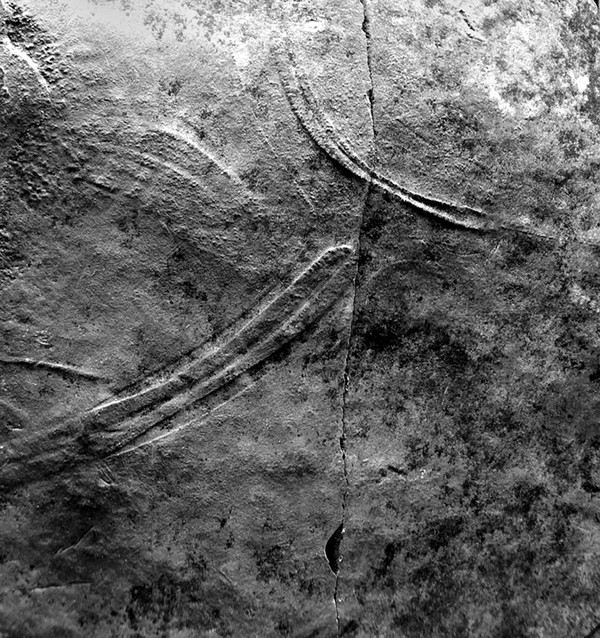
by Timothy Oleson Friday, August 8, 2014

An Archaeonassa trace fossil identified in carbonate rocks from the Bambuí Group in Brazil is thought to have been left by an organism during the Late Ediacaran. Credit: Lucas Warren.
Fossils of a known age have been found for the first time in rocks in Brazil that, although long-studied, had previously eluded scientists’ attempts to pinpoint their age. The discovery of the marine animals dates the rocks to 550 million years ago, researchers say, offering important insights into the geological evolution and timing of the assembly of the former supercontinent Gondwana.
Gondwana’s origins date to the breakup of its predecessor, Rodinia, starting roughly 850 million years ago in the Early Neoproterozoic. Portions of what are now Africa, Antarctica, Australia, India and South America then began slowly reorganizing and fusing together piece-by-piece to form the new supercontinent, the assembly of which is thought to have finished in the Middle Cambrian about 510 million years ago. Many details of the process along the way remain unclear, however.
To help piece together Gondwana’s history, some prior studies have looked at “fold belts” in eastern South America and western Africa, which formed as rock at the margins of different landmasses collided with one another and deformed. Based on these studies, it has been thought that several “proto-Gondwanan” landmasses — including the São Francisco, Congo, Rio de la Plata, Kalahari and Paraná cratons — had merged together by 600 million years ago, or perhaps earlier. But a new study in Geology suggests that even 50 million years later these cratons hadn’t fully fused and were actually still separated by a shallow sea.
Lucas Warren, a geologist at Universidade Estadual Paulista in Brazil and lead author of the study, and his colleagues studied rock cores collected from a section of the well-known Bambuí Group near the Brazilian town of Januária, an area that was part of the São Francisco Craton during the Neoproterozoic. The Bambuí Group consists of shallow marine and tidal-zone carbonates thought to have been entirely deposited prior to 600 million years ago, as the São Francisco and its neighboring cratons were completing their unification.
But near the bottom of the core, and hence early in the deposition of the Bambuí Group, the researchers found the fossilized tube-shaped shells of an organism called Cloudina, known from specimens found elsewhere to have lived during a geologically short period between 550 million and 542 million years ago. Along with other fossil organisms and trace fossils identified in the core and thought to date to the Late Ediacaran, the Cloudina suggest that, rather than being older than 600 million years, the Bambuí Group rocks are likely at least 50 million years younger, Warren says.
What’s more, Cloudina specimens have also been found near the lithified ancient coastlines of other chunks of the proto-Gondwanan supercontinent — of which the São Francisco formed part of the interior — suggesting that a large inland sea wove amid the landmasses and connected them to the ocean at the time. This sea “was probably a branch of the Clymene Ocean,” Warren says, which “separated the proto-Gondwana supercontinent to the west from the Amazonia and Rio Apa cratons to the east.” (Amazonia and Rio Apa would later collide and merge with the rest of Gondwana.)
“This is a very important finding,” says Eric Tohver, a geologist at the University of Western Australia who was not involved in the new study. Many researchers have studied and interpreted the history of the Bambuí Group “without any firm notion as to what the age of the rocks actually is” because the age-determination methods used previously have been indirect or less precise, he says.
“It’s rare to find a paleontological [indicator], in a sequence that has been looked at for decades, that so precisely establishes the age,” Tohver says. “By establishing that these rocks are much younger than had been supposed … that pushes back the date of formation of [this part of] Gondwana by some 50 million to 100 million years.”
The findings raise some new questions about Gondwanan evolution in the area, Warren says, such as why portions of Bambuí Group rock appear to have been folded and deformed by tectonic processes that took place well over 550 million years ago. Addressing this and other problems, he says, “will lead to many revisions of the geology of central South America.”
© 2008-2021. All rights reserved. Any copying, redistribution or retransmission of any of the contents of this service without the expressed written permission of the American Geosciences Institute is expressly prohibited. Click here for all copyright requests.